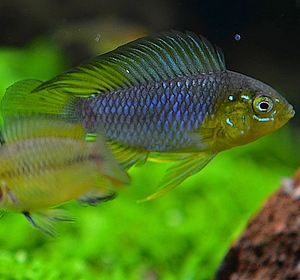
| Species | Umbrella Cichlid |
|---|---|
| Other names | Borelli's Dwarf Cichlid |
| Latin Name | Apistogramma Borellii |
| Family | cichlids |
| Origin | Ameryka Południowa |
| Length | 6 - 7 cm |
| Temperature | 21 - 26°C |
| Water Hardness | soft - medium hard |
| pH | 6.0 - 7.5 |
| Aquarium Size | 100 L |
| Food | live, frozen, dry |
Umbrella Cichlid, Borelli's Dwarf Cichlid
A freshwater species which can be found in the wild in shallow and shaded streams, brooks, ditches, and tributaries of the Paraguay and Paraná rivers in Brazil, Paraguay, and Argentina.
The coloration of this species directly depends on the habitat it comes from. In aquariums, there are also numerous selectively bred varieties: yellow, blue, opalescent. The basic version is characterized by a bluish colour of the body and fins with a yellow head and yellow fin tips. Sometimes along the sides of the body a dark, intermittent line is visible, and on the head opalescent blue spots and/or red spots. The male is larger, more vividly colored, and his fins (dorsal and anal) are more elongated compared to the female's fins.
Essentially, it is a calm yet territorial cichlid, unless it is a wild-caught specimen or a female during spawning. In such cases, having a larger number of fish will allow their aggression to be dissipated within the group – however, we must have a sufficiently large aquarium, with an adequate number of hiding places. We should avoid mixing species from the genus Apistogramma to prevent possible hybridization. The females of this species are incredible mothers who fiercely protect their offspring. They do not shy away from confrontation with fish much larger than themselves, and if the threat is serious they signal the fry to hide with movements of their own body. Then the young cling motionlessly to the substrate and wait until the danger has passed.
The Reitzig's cichlid requires a spacious aquarium with sandy substrate, numerous hiding places among roots, branches, stones, caves, coconut shell halves, pots, dimmed and diffused lighting, water stained to a tea color (addition of peat to the filter or suspending a net filled with peat directly in the tank), addition of dried leaves (beech or oak – replace them every few weeks). The addition of plants is not necessary but recommended (e.g., Anubias, Cryptocoryne, Java moss). Water flow should be moderate, and partial water changes regular - the fish are sensitive to nitrates.
An oviparous species. To induce spawning, the fish are stimulated by feeding them live food, raising the water temperature, lowering its pH and hardness. Necessary hiding places, plants, and subdued lighting (the addition of floating plants seems to be a good idea). There should be 2-3 females to each male. The female lays eggs (about 50) in available indentations and crevices of decorative elements or at their base. The female then takes care of the eggs and fry and can become very aggressive, also towards the male (especially likely in too small an aquarium). Larvae hatch after 2-4 days (depending on the water temperature), and after a week they swim freely in search of food. The fry are sensitive to water quality.